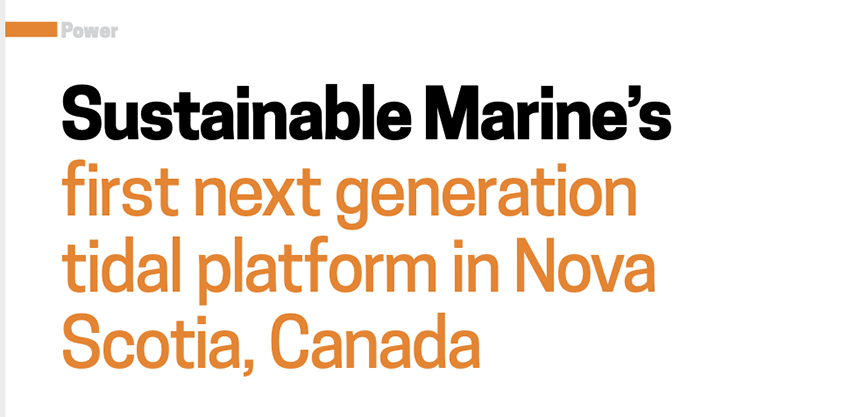Sustainable Marine CEO Jason Hayman explains how the firm’s next-generation tidal platform – recently unveiled in Nova Scotia, Canada – offers a future portent to clean ocean energy.
jason hayman – sustainable marine
By Jason Hayman, Sustainable Marine CEO
The ocean is the world’s largest untapped energy source containing an estimated 3-Terawatts of power. The amount of tidal energy which is technically harvestable lies somewhere around the 1-Terawatt mark. Besides, it is largely located near islands and long stretches of coastline.
Thus, Sustainable Marine CEO Jason Hayman explains how the firm’s next-generation tidal platform – recently unveiled in Nova Scotia, Canada – offers a future portent to clean ocean energy forming part of the world’s first floating tidal array.
((( Read more of our articles’ content, here )))
Tidal for resiliency
Undersea currents are one of the oldest forms of power known to man; with natural energy produced by the surge of ocean waters during the rise and fall of tides. In fact, by the 20th century, engineers had devised many methods to use tidal movement to generate electricity in areas where there is a significant tidal range; all of which used special generators, drawing energy from currents in much the same way as wind turbines.
Tidal stream power systems take advantage of ocean currents to drive turbines, particularly where these currents are fast. They can be installed as tidal fences, where turbines are stretched across a channel, or as tidal turbines, such as Sustainable Marine’s PLAT-I system (PLATform for Inshore energy), which resemble underwater wind turbines.
Thus, the PLAT-I technology offers an innovative take on tidal energy, through a floating platform, which is the first of its kind in the world. Indeed, its modular design enables it to be easily assembled on-site and only requires 2 meters of water for launching.
Meanwhile, the system is moored with a turret configuration allowing it to ‘weather-vane’ with the tide or river flow. PLAT-I’s turbines are also mounted on SIT Deployment Modules (SDMs) allowing them to be quickly raised above the surface for inspection and maintenance, while also reducing draft during transit.
A key advantage of tidal energy is it predictability and reliability with daily, bi-weekly, biannual and even annual cycles over a number of years. This energy source can generate energy both day and night. Given that power varies with the density of the medium, tidal power can also be the product of much slower rotation speeds compared to wind. (6 RPM tidal versus 20 RPM wind), and smaller rotor diameters (15-meter tidal versus 45-meter wind).
Potentialities across the Atlantic
Tidal energy only requires water speeds at one-tenth of the speed of wind to provide the same power for the same size of turbine system. By comparison, an underwater turbine is able to generate energy at 2.2mph. On the other hand, a wind turbine would need speeds of 7-9mph to produce power. Furthermore, at higher speeds in a flow between 2 to 3 metres per second; a marine turbine can typically access four times as much energy per rotor swept area. In fact, as a similarly rated power wind turbine.
A number of world’s superpowers benefit from strong tidal resources with 20plus countries now making significant investments in the market. For instance, including the USA, Canada, UK, China, Japan, South Korea, Australia, New Zealand, Chile, France, Spain, Portugal, Germany and Sweden. Back in 2014, the global energy market for this energy source valued at around $480million. However, experts now believe this will surge to circa 11.3bn by 2024.
The UK alone holds around 50pc of Europe’s marine energy resource, with studies estimating it possesses a total of 25 to 30GWs. Indeed, enough to supply around 12pc of UK’s current electricity demand. For instance, the majority of which is located in the Severn estuary (which has between 8 and 12GW). Also, with the estuaries and bays of the northwest experiencing a similar volume, and the east coast a further 5 to 6GW.
Opportunities
Across the Atlantic, Canada holds an estimated 35GW of ocean energy; enough clean power to displace over 113 million tonnes of CO2, equal to removing over 24 million cars off the road. The Minas Passage area of the Bay of Fundy, which is the end destination for Sustainable Marine’s floating array; attracts around 7GW of the nation’s marine power, which could power two million homes – or all of Atlantic Canada.
As this industry prepares to take larger and faster strides than ever before; continued public and private sector support will be crucial. Notably, to ensure the delivery of full-scale demonstrations on route to commercialization. Thus, helping to unlock the full potential of this rapidly evolving clean technology.


